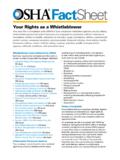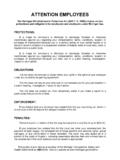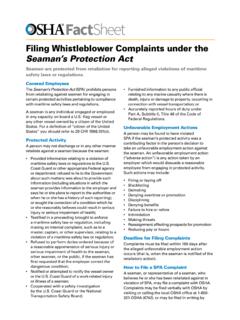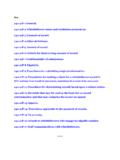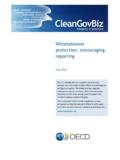Transcription of The Whistleblower Protection Act: An Overview
1 Order Code RL33918. The Whistleblower Protection Act: An Overview March 12, 2007. L. Paige Whitaker Legislative Attorney American Law Division The Whistleblower Protection Act: An Overview Summary This report discusses the federal statutory protections contained within the Whistleblower Protection Act (WPA) for federal employees who engage in whistleblowing, that is, making a disclosure evidencing illegal or improper government activities. The protections of the WPA apply to most federal executive branch employees and become applicable where a personnel action is taken because of a protected disclosure made by a covered employee. Generally, Whistleblower protections may be raised within four forums or proceedings: (1). employee appeals to the Merit Systems Protection Board of an agency's adverse action against an employee, known as Chapter 77 appeals; (2) actions instituted by the Office of Special Counsel; (3) individually maintained rights of action before the Merit Systems Protection Board (known as an individual right of action, or IRA); and (4) grievances brought by the employee under negotiated grievance procedures.
2 On March 9, 2007, the House Committee on Oversight and Government Reform reported 985 (110th Cong.) 110-42, the Whistleblower Protection Enhancement Act of 2007, which would amend the WPA by providing protections for certain national security, government contractor, and science-based agency whistleblowers, and by enhancing the existing Whistleblower protections for all federal employees. Contents Introduction and Background .. 1. Essential Elements Triggering Application of the Whistleblower Protection Act (WPA) .. 2. Covered Employees .. 2. Protected Disclosures .. 3. Any Disclosure of Information .. 3. Reasonable Belief .. 4. Subject Matter of Disclosure .. 4. Disclosures to Members of Congress .. 5. Personnel Actions .. 5. Nexus Between a Protected Disclosure and a Personnel Action .. 7. Other Protected Activities .. 7. Forums Where Whistleblower Protections May Be Raised .. 8. Chapter 77 Appeals .. 8. Actions by the Office of Special Counsel (OSC) .. 9. Investigations .. 10.
3 Corrective Actions .. 11. Disciplinary Actions .. 12. Intervention .. 12. Stays .. 12. Individual Right of Action (IRA) .. 13. Negotiated Grievance Procedures .. 13. Summary of the Whistleblower Protection Enhancement Act of 2007. ( 985, 110th Congress) .. 14. The Whistleblower Protection Act: An Overview Introduction and Background The Whistleblower Protection Act (WPA) provides statutory protections for federal employees who engage in whistleblowing, that is, making a disclosure evidencing illegal or improper government activities. The protections of the WPA. apply to most federal executive branch employees and become applicable when a personnel action is taken because of a protected disclosure made by a covered employee. Generally, Whistleblower protections may be raised within four forums or proceedings: (1) employee appeals to the Merit Systems Protection Board of an agency's adverse action against an employee, known as Chapter 77 appeals; (2). actions instituted by the Office of Special Counsel; (3) individually maintained rights of action before the Merit Systems Protection Board (known as an individual right of action, or IRA); and (4) grievances brought by the employee under negotiated grievance procedures.
4 When Congress first enacted the Whistleblower Protection Act (WPA) in 1989, it stated that the intent of the legislation was to: strengthen and improve Protection for the rights of Federal employees, to prevent reprisals, and to help eliminate wrongdoing within the Government by (1). mandating that employees should not suffer adverse consequences as a result of prohibited personnel practices; and (2) establishing .. that while disciplining those who commit prohibited personnel practices may be used as a means by which to help accomplish that goal, the Protection of individuals who are the subject of prohibited personnel practices remains the paramount The operative statutory protections of the WPA are embodied in its definition of prohibited personnel practices : 2302. Prohibited personnel practices (b) Any employee who has authority to take, direct others to take, recommend, or approve any personnel action, shall not, with respect to such authority .. (8) take or fail to take, or threaten to take or fail to take, a personnel action with respect to any employee or applicant for employment because of.
5 (A) any disclosure of information by an employee or applicant which the employee or applicant reasonably believes evidences (i) a violation of any law, rule, or regulation, or (ii) gross mismanagement, a gross waste of funds, an abuse of authority, or a substantial and specific danger to public health or safety, if such disclosure is not specifically prohibited by law and if such information 1. 5 1201 nt. CRS-2. is not specifically required by Executive Order to be kept secret in the interest of national defense or the conduct of foreign affairs; or (B) any disclosure to the Special Counsel, or to the Inspector General of an agency or another employee designated by the head of the agency to receive such disclosures, of information which the employee or applicant reasonably believes evidences (i) a violation of any law, rule, or regulation, or (ii) gross mismanagement, a gross waste of funds, an abuse of authority, or a substantial and specific danger to public health or safety;2.
6 Essential Elements Triggering Application of the Whistleblower Protection Act (WPA). In order to trigger the protections of the WPA, a case must contain the following elements: a personnel action that was taken because of a protected disclosure made by a covered Covered Employees Although anyone may disclose whistleblowing information to the Special Counsel for referral to the appropriate agency, the Special Counsel may order an investigation and require a report from the head of the agency only if the information is received from a covered employee. In addition, with few exceptions, prohibited personnel practices apply only to covered employees. Hence, as a threshold matter, it is important to note which federal employees are statutorily covered. Generally, current employees, former employees, or applicants for employment to positions in the executive branch of government in both the competitive and the excepted service, as well as positions in the Senior Executive Service, are considered covered However, those positions that are excepted from the competitive service because of their confidential, policy-determining, policy- making, or policy-advocating character, 5 and any positions exempted by the President based on a determination that it is necessary and warranted by conditions of good administration,6 are not protected by the Whistleblower statute.
7 Moreover, the statute does not apply to federal workers employed by the Postal Service or the Postal Rate Commission,7 the Government Accountability Office, the Federal Bureau of Investigation, the Central Intelligence Agency, the Defense Intelligence Agency, the National Imagery and Mapping Agency,8 the National Security Agency, and any other 2. 5 2302(b)(8). 3. Id. 4. 5 2302(a)(2)(B). 5. 5 2302(a)(2)(B)(i). 6. 5 2302(a)(2)(B)(ii). 7. 5 2105(e). 8. The Central Imagery Office was exempted from coverage with the passage of the 1994. ( ). CRS-3. executive entity that the President determines primarily conducts foreign intelligence or counter-intelligence Protected Disclosures [A]ny disclosure of information that a covered employee reasonably believes evidences a violation of any law, rule, or regulation or evidences gross mismanagement, a gross waste of funds, an abuse of authority, or a substantial and specific danger to public health or safety is protected on the condition that the disclosure is not prohibited by law nor required to be kept secret by Executive Moreover, any disclosure made to the Special Counsel or to the Inspector General of an agency or another employee designated by the head of the agency to receive such disclosures, which the employee reasonably believes evidences a violation of any law, rule, or regulation, or evidences gross mismanagement, a gross waste of funds, an abuse of authority, or a substantial and specific danger to public health or safety is also Agency heads are required to inform their employees of these Any Disclosure of Information.
8 The WPA expressly provides that any disclosure of information is protected. With enactment of the WPA, Congress amended its statutory predecessor, the Civil Service Reform Act (CSRA).13 In so doing, it changed the phrase a disclosure to any disclosure, emphasizing the point that the courts, the OSC, and the MSPB should not erect barriers to disclosures that will limit the necessary flow of information from employees with information of government In the Committee Report accompanying the WPA. legislation, the Senate specifically criticized a 1986 decision by the Court of Appeals for the Federal Circuit, Fiorello v. Department of Justice,15 where an employee's disclosures were found not to be protected because the employee's primary motivation was not for the public good, but rather was for personal The court reached this conclusion despite a lack of any indication in the 8. (..continued). WPA amendments. The agency was renamed the National Imagery and Mapping Agency . with the passage of the National Defense Authorization Act for Fiscal Year 1997.
9 104- 201, 1122(b)(1). 9. 5 2302(a)(2)(C). 10. 5 2302(b)(8)(A). 11. 5 2302(b)(8)(B). 12. 5 2302(c). 13. Civil Service Reform Act of 1978, 95-454, 92 Stat. 1114. 14. 100-413 (1988) at 13. 15. 795 1544 (Fed. Cir. 1986). 16. 100-413 (1988) at 13. CRS-4. Civil Service Reform Act that employee motives were relevant to deciding whether a disclosure is Following enactment of the WPA in 1989, case law did not reflect the statutory expansion of a disclosure to any disclosure. This lack of responsiveness by the courts and the MSPB was one factor prompting Congress in 1994 to amend the Whistleblower statute. As the House report accompanying the 1994 amendments notes: Perhaps the most troubling precedents involve the Board's inability to understand that any means any. The WPA protects any disclosure evidencing a reasonable belief of specified misconduct, a cornerstone to which the MSPB. remains blind. The only restrictions are for classified information or material the release of which is specifically prohibited by statute.
10 Employees must disclose that type of information through confidential channels to maintain Protection ;. otherwise there are no Reasonable Belief. For a disclosure to be protected, an employee must have a reasonable belief that the information is true. This is substantially a good faith requirement. In theory, the actual veracity of any disclosure does not affect whether a disclosure is In addition, for those disclosures enumerated under section 2302(b)(8)(A) that do not have to be kept confidential, the statute does not specify to whom the disclosures must be made in order to qualify as Subject Matter of Disclosure. The statutory language of the Whistleblower protections requires the disclosure to (a) evidence (i) a violation of any law, rule, or regulation, or (ii) gross mismanagement, a gross waste of funds, an abuse of authority, or a substantial and specific danger to public health or safety; and (b) not be prohibited by law or Executive Order, except when the disclosure is made to the Special Counsel or to the Inspector General of an agency or another employee designated by the head of the agency to receive such The WPA limits evidence of mismanagement to only gross mismanagement.










